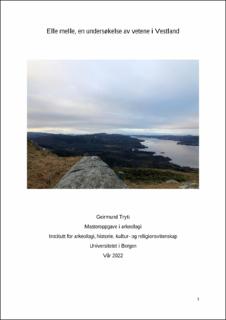Elle melle, en undersøkelse av vetene i Vestland
Master thesis
Permanent lenke
https://hdl.handle.net/11250/2999140Utgivelsesdato
2022-05-20Metadata
Vis full innførselSamlinger
- Master theses [240]
Sammendrag
In Norway, there is a living tradition of a system of bonfire beacons (veter) on mountaintops meant to mobilise the levy in case of war. This system is thought to date all the way back to the beginning of the formation of the Norwegian state at the end of the Viking era, and was in use up until the Napoleonic Wars. The small amounts of research about this system has predominantly been done by historians, and there has been less than a handful of archaeological excavations pertaining to them. In the following, this system will be described, and the material culture that can be associated with it will be discussed. Based on this, a test pit in the remains of a watchhouse on the mountain Veten in Bergen was dug, yielding dates showing several different phases of use since the 15th century. Additionally, the system in Vestland county will be mapped, based on placenames, old traditions and historical documents, to make a digital reconstruction of the system. This reconstruction serves as a model used to analyse the system in a GIS. The analysis results show a system of beacons all along the coast and into the deep fjords. While the beacons have been placed to send a warning signal to each other and everyone who can see them, they also seem to be placed to guard and control the sea lanes in several places. Two instances of this are shown in this thesis, one of which concerns the area around the Gulating, where a ring of five beacons seems to protect the site of the legislative assembly. One particular part of the system stands out due to a different naming tradition, which might be connected to military reforms in the late 13th century and baron Audun Hugleiksson.
